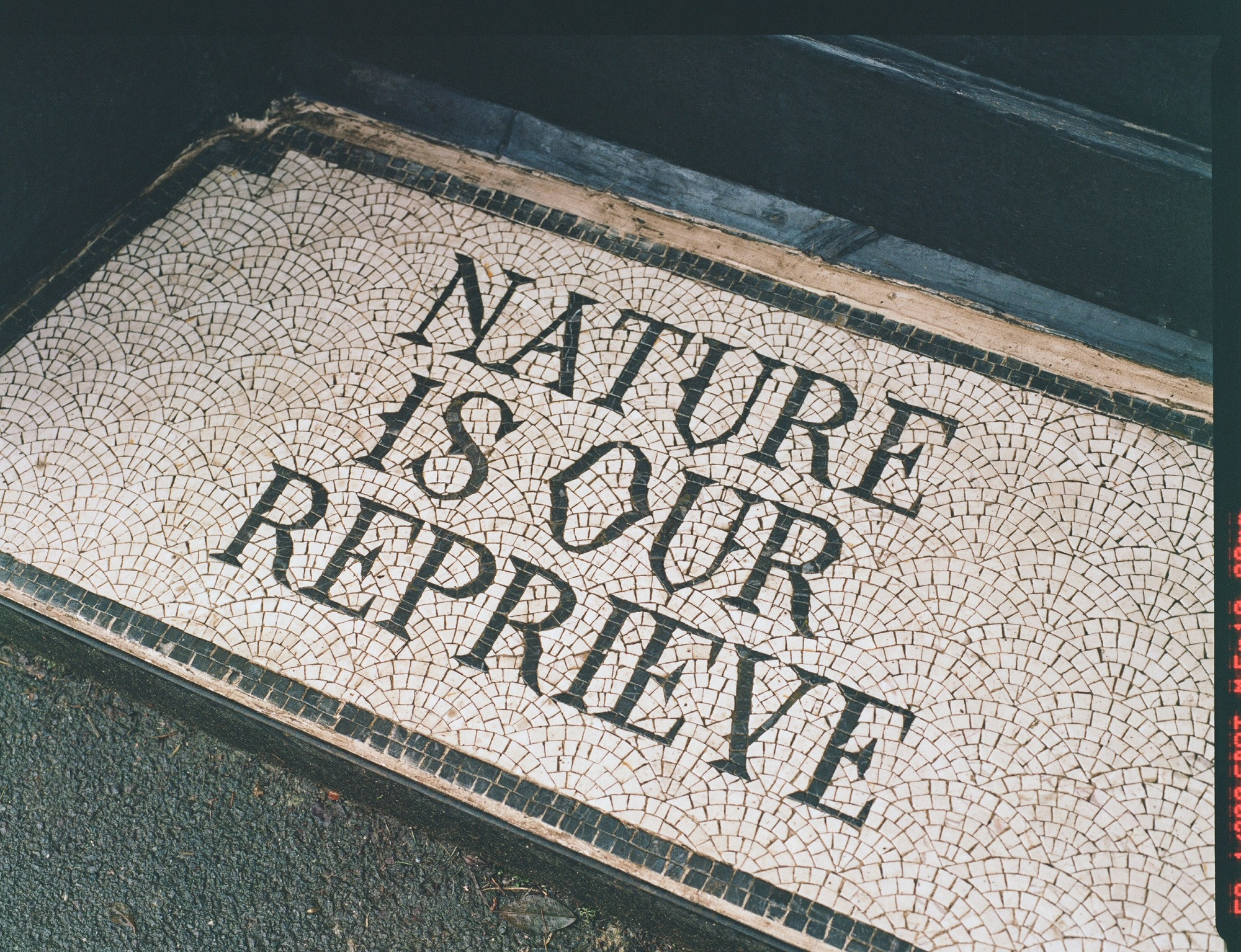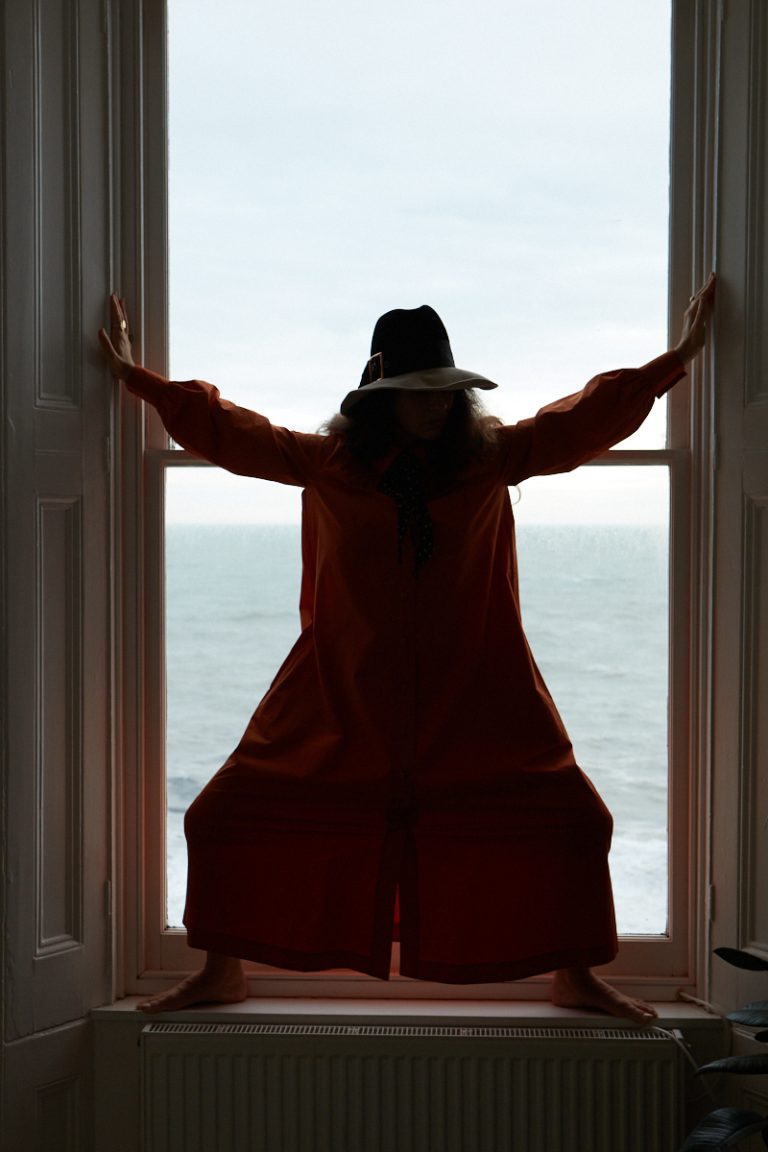
In Love and In Fury
Published: 2021/11/28
Updated: 2021/11/29
KATIE EBBITT: You worked numerous years in the London art scene before deciding to change your life’s direction. Can you tell me about this decision?
LEILA SADEGHEE: I was in Berlin. And I was really trying to get it all going on in the art world, having moved to Berlin from London. And I put myself under a lot of stress. I was really young, also. I was only 23. And it was a real boy’s club, the art world in Berlin at that time. I mean, possibly is still now. I have no idea. But it was a real challenging time for me, and I was going through so much inner turmoil. An ex-boyfriend of mine had died a year or two before. I was very stressed after I finished my degree, and really I put a lot of pressure on myself to be successful and to have my life look a certain way. And I wanted it to happen just immediately. I just didn’t really have any kind of maturity about it or sense of developing things. I kind of wanted a ‘just add water’ kind of success situation for myself.
I woke up one morning and I was aware that the voice in my head wasn’t me. I was aware that the thinking voice was not who I really am. But then I wasn’t at all clear on what that information meant. It was this kind of fragment of a piece of information. There was this sudden fragmentation. Whereas I really had never given it any thought before. For me, my thinking mind, the voice in my head, my body, my name, all of the particular qualities of my being, of being half Iranian and half white American, and being raised in the suburbs and working in the art world… All these kind of things were very fixed, sticky points of identity for me. And it was all glommed together into one lump that I would call ‘me’.
And then suddenly, that lump just started to come apart. And I was aware that this thinking mind is not who I am. And I kept thinking, ‘I need to wake up. I need to wake up.’ And I knew what I meant was to wake up spiritually. My friend’s father was Hal Douglas, and Hal said to me more than once, ‘Wake up, Leila.’ I had no idea what Hal had meant, but suddenly I was telling myself that, and I didn’t know what that meant either.
I started to really hear all of the things this voice in my head was saying to me, and this voice was saying terrible things all the time. This voice in my head was very neurotic and insane, like most people describe their experience of their minds at one point in time or another. I was in quite a lot of anxiety at that moment in my life.
I called my friend, who’s the daughter of Hal Douglas, who had a spiritual practice. I started going to the library. It was 1998. So, I would go to the library to go on a computer and get online. And I’d be Googling ‘meditation’, and the screens would be loading slowly. I’m looking up, there’s Vipassana retreats, and I was trying to find out... My cousins had been meditating with Thich Nhat Hanh for a number of years. One of my cousins was in his order. So, I was looking at that. I was trying to get to Plum Village [Buddhist monastery co-founded by Thich Nhat Hanh]. But this all happened right at the end of July in Europe. And certainly nowadays, Europe starts to shut down for August. It’s just not open. In the 90s, even more so. I was in a real mess. I didn’t know what to do with myself.
But I found a meditation class and I just slowly started to piece it together at that time. The first thing to do, the first order of business, was to get to a meditation class.
And was it your first time meditating, when you walked into that meditation class?
Actually, what I did—I’ll tell you what I did. I went to the English language bookstore in Berlin. I cycled across town. It’s the only English language bookstore, and I was in the east. But, I went west, in West Berlin. And I went, and I went to their spirituality, Eastern religion, yoga, Buddhism section. So, all those things lumped together in one shop. And there were six books on that shelf. And I bought two of them.
I bought a book on Tibetan Buddhism. And I bought a book called Dreambody [: The Body’s Role in Healing the Self], by a guy called Arnold Mindell. And I started reading The Tibetan Book of Living and Dying [by Sogyal Rinpoche] and instantly felt very drawn to tantric Buddhist practice, which is what that book is about. It’s about Tibetan Buddhism, which is a form of tantric Buddhism. And all of the teachings about compassion and about relatedness really started speaking to me, to the point that I remember starting to have these experiences where I was feeling all this love for the people in my life and this renewed sense of connection to people who were very far away. I was in Berlin. They were in New York, or in the States, or wherever. And then was reading that this cultivation of Metta [Buddhist meditation] was actually a practice from the tradition. I would sort of intuitively just start doing things, very naively, and find out that they were practices from that tradition.
Meanwhile, I thought, ‘All right. Well, I need to sit and meditate properly.’ I read in the Arnold Mindell book, ‘sit and light a candle’. I sat down and I followed the instructions that I read in the book. And I meditated probably for, like, five minutes, and suddenly my heart started to... I want to say it just started to quiver. It felt like my heart exploded. And then I remember my hands went numb. And tears were pouring down my face. And of course now I understand that that was the most self-compassionate act of my entire life to date. That was the first time I’d done anything to really show myself love. And now, I understand that. But I’d been so hard on myself all along, all those years.
But at the time, I was completely freaked out. I thought, ‘What is this meditation? Something’s happened to me.’ So, I sit there crying with my heart exploding and my hands completely numb. And suddenly I thought, ‘All right. I don’t think I can handle this anymore.’ I blew out the candle and I went to bed.
It sounds like you were really very much in your body at that moment.
Absolutely. I was always a pretty sensate person, physically. I had a lot of body pain as a child, so I was very oriented around my physical pain. I’m not one of those people who was like totally out of body all along. Although I was very unathletic, I like to dance. Yeah. I was connected to my body, but I was also—I realise now—I was orienting towards my innermost self for the first time in my life. And for me, that was a very powerful moment. I had nobody to talk to. It’s so different now. Somebody does something like that now, they can connect on Instagram. You get curious about spirituality, and there’s a million prescriptions of what to do. In those days, you just had to somehow get lucky or run into someone who knew something.
After the experience of your five-minute meditation, you decided to connect to this meditation group within Berlin?
Yeah. I found a Buddhist meditation group and I started going. And then, that was actually how I started... I mean, I’d done asanas before. I’d attended yoga class before, several times. But when I went to that class, I went to the meditation class so desperate for relief from this mind. And of course, I sat in the silence, followed the instructions thinking, ‘Maybe it’ll be okay,’ and instead it amplified, of course. Which is very common also. And then I remember just crying because I was so unhappy. And everybody else looked beatific, these white people, calmly, with the meditation shawl, sitting on a zabuton. I mean, the whole thing.
And I went up to the teacher afterwards and I explained my situation, so bereft and broken-hearted. And he said, ‘You know,’—in a German accent. He said, ‘We have a yoga class before the meditation class. And sometimes people find that it helps to meditate if you do the yoga before.’ So then, I started going to the Iyengar class before the meditation class, and that became a kind of formulation. And then it was true. I could kind of sit there. I could kind of start it.
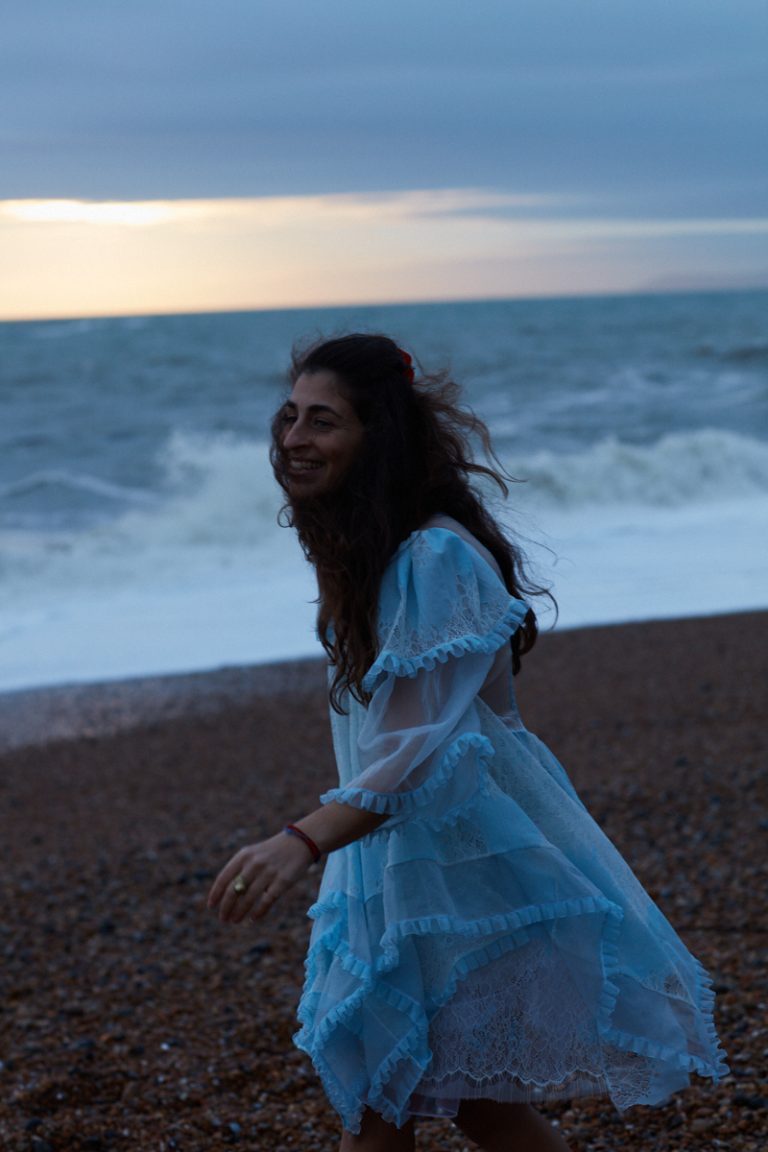
Dress BORA AKSU.
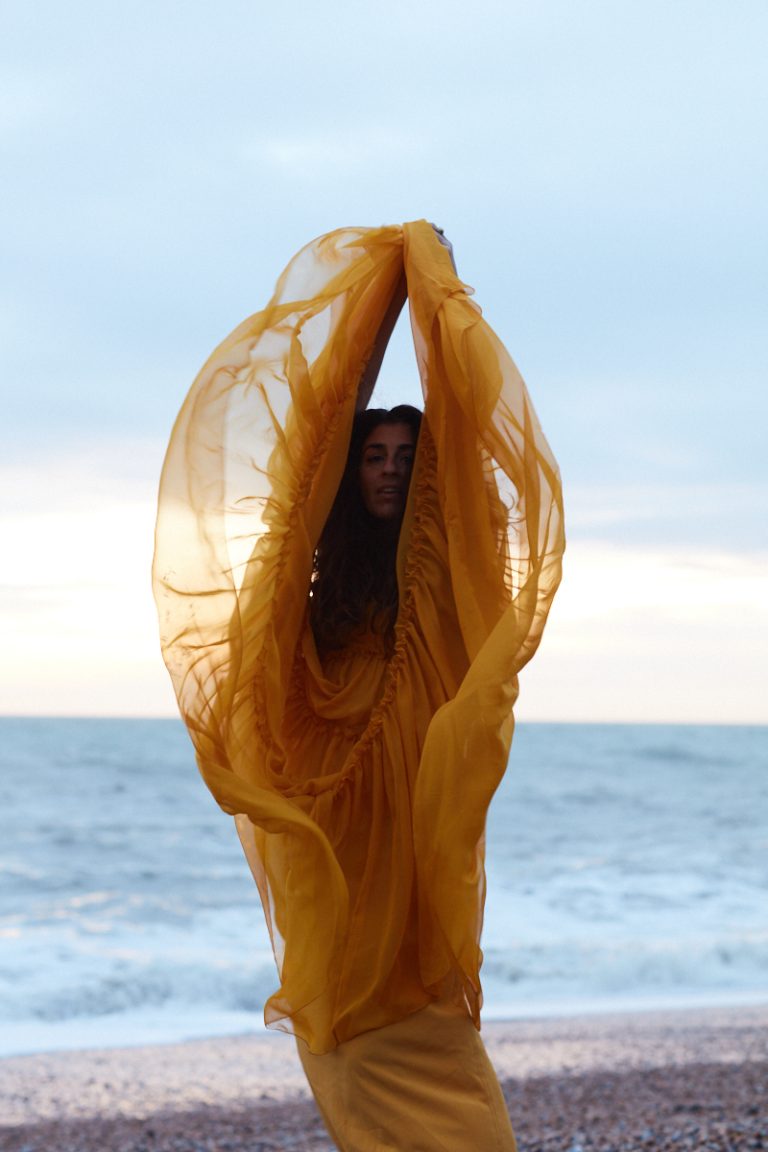
Dress ALBERTA FERRETTI.
"I thought, "What is this meditation? Something's happened to me." So, I sit there crying with my heart exploding and my hands completely numb. And suddenly I thought, "All right. I don't think I can handle any more." I blew out the candle and I went to bed." —LEILA SADEGHEE
There’s such a re-evaluation of worth during the pandemic. Re-evaluation takes also a lot of cultivation of trust in yourself. I’m wondering, how did you do that? It’s hard to rework or rewrite a personal narrative.
One thing about me is that I definitely am persistent. And I just doggedly chipped away at it. And also, there’s grace. I think one of the things that just by way of... The fundamental encouragement that I now share in my role as a healer and as a facilitator and as a teacher and as a guide is really to support people in leaning in to the grace that’s present in life, to just start to look for it and to see it. And I think I mentioned that in the 90s, I couldn’t just Google anything. It wasn’t just at my fingertips. I couldn’t connect with somebody by distance who just knows a bunch of stuff. I would have to run into that person.
But I did run into some people. And rather incredibly, some close friends of mine, separately and on their own, had started to turn to yoga and spiritual practice. And incidentally, for somebody of my... I’m very late Gen X, I guess, that would be what I’m called. On the later side. And this was not considered cool. It was considered cool to be a kind of rugged, successful individualist who has some sort of wild vision of something that then you could manage to sell to everybody. And I had a lot of doubt in myself through every little stage.
But what I did do is I got myself into spiritual practices. I think one of the great teachings that I’ve ever heard is ‘keep company with the saints’. And I seemed to have enough good sense, even though I honestly used to put myself down for it. Like, ‘Why don’t I have any cool friends? And nobody I know can get me into the clubs.’ Or whatever. Obviously, my friends could get me into clubs. But whatever. The old art world thing. It’s not like I was some big cheese when I was in the art world, by any stretch. But it just felt like maybe life was happening outside somewhere, and that I wasn’t in on... I had to just wade through all of that nonsense.
But the thing is, the practices work. And especially if you combine... I mean, this I why my offerings are structured the way that they are. It’s because I’m aware that the practices work. And I’m aware that if you do the practices and surround yourself with at least a few people, if not a lot of people, who are also doing the practices... Incidentally, this is the formulation of the Buddha. It’s the formulation of Buddha, Dharma, Sangha—which is the principle of awakening, as a lived, as an embodied possibility. As, here’s an actual thing that can happen, thing. Like the Buddha, the state of awakening itself, and then the prospect of awakening that is a real thing. Dharma is all your practices and everything about life once you’ve oriented yourself to Buddha. And then Sangha is other people doing the same thing. Those are known as the Three Jewels. They are luscious, radiant jewels. I mean, I’m not a practicing Buddhist, but I do find this teaching very compelling.
Yeah. Dogged, persistent commitment to my healing, therapy, healing, throwing spaghetti. Throwing healing like spaghetti at a wall to see where it would stick.
Healing can be so hard to articulate. Healing is about finding personal essence, finding truth, and trusting yourself to actually know who you are. It’s such a difficult thing to do.
You can’t trust yourself without having trust in life. Because the whole awakening thing is really the kind of direct apprehension that there is nothing in you that is not life, and nothing in life that is not you. It’s like the whole sense of separateness from world undergoes a profound reconfiguration under the auspices of direct perception. So then, a lot of things happen—profound intimacy with the world, because an awake person can no longer see the world as fundamentally separate from them.
But there’s dimensions of awakening too, so if it doesn’t hit the heart, if it doesn’t hit the whole of yourself, it can be very disassociating because you can feel like it can all feel really spacious. The spiritual teachers aren’t... It’s not good enough to just do the spirit for spirit’s sake. I think the tradition, the lineage of activists, feminists, people who’ve been working through liberation theology, all these sorts of things become really important. Especially now, if anybody wants to get any kind of traction on awakening. Because the days when we can afford to just disassociate are definitely over.
But it’s having trust in life, especially if you’re somebody who’s not travelling in a racialized-as-white body. If you’re not a white person, how do you trust in life? Because there’s so much not to trust. Or, you disassociate from your lived experience in order to survive. And this is just talking about one frame of experience. There’s many other frames of experience. But these, to me, are very salient questions.
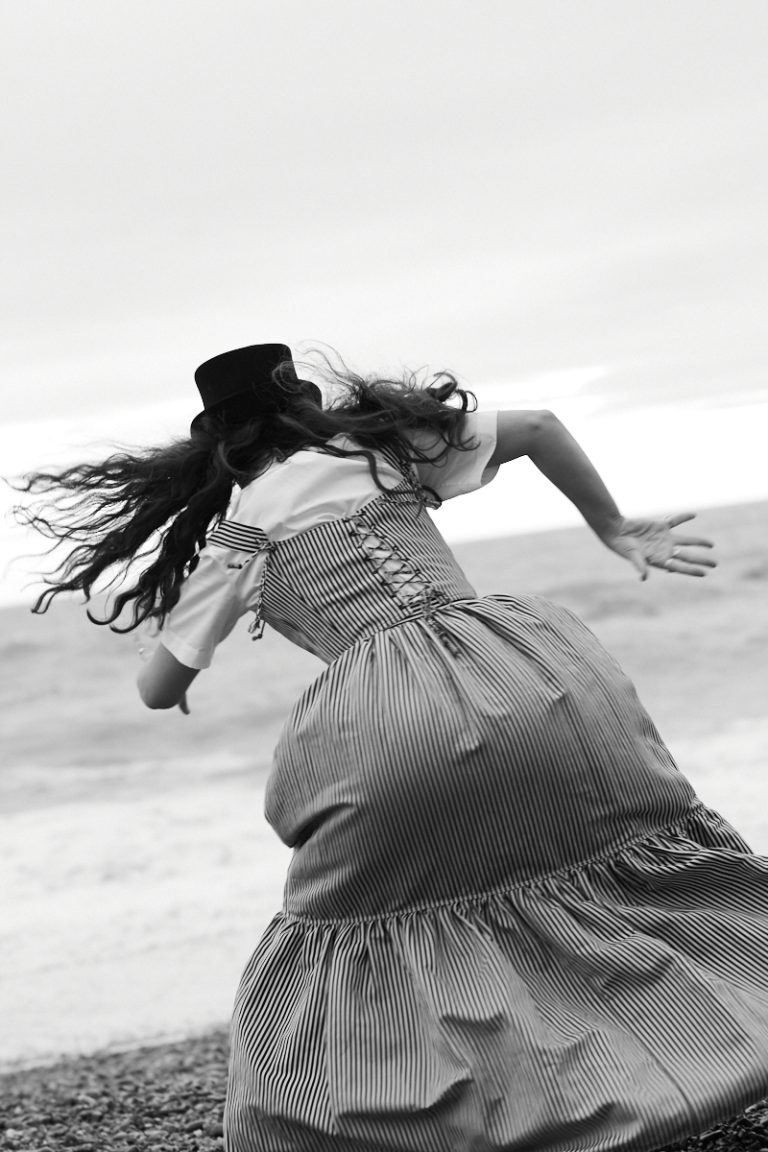
All clothing CHRISTIAN DIOR, Hat VINTAGE PIERRE CARDIN.

In your Instagram bio, it reads, ‘Awake woman of colour in love and in fury’. And I was wondering if you could speak more to holding that dialectic of love and fury? Particularly as it relates to race and systems of oppression.
In my practice, spiritual awakening and spirit practices so far, the metaphor of the holy fire or the divine fire is a pretty strong one. Which is to say that there’s a part of awakening which is... We could call it a purificatory process. And people think of purificatory, they think about, ‘Oh, now I’m going to eat vegan and do…’ No. It’s not that. The purifying is a purifying of your distorted understandings of reality. Now, sometimes it’s the case that you need to clean up your act, so to speak, in order to have access to that kind of purification. But certainly not always.
And the purificatory fire is burning away everything that disallows you from seeing what’s going on. I’ve found in a lot of spiritual circles... I’ve travelled in a lot of spiritual circles. It’s a lot of, I’m going to say, very privileged spiritual circles. But not exclusively privileged spiritual circles, but many. And what I’ve seen is that it becomes completely focused on self-identity, to the point where we’re meant to dissolve every... The emphasis is put on dissolving all of the, what one of my teachers calls the ‘individual identity assemblage point loci’. Which is to say, the places where we are, like I was, all glommed together. Like, okay, this is me. But it’s not the truth of me. The truth of me is wild freedom.
So, there’s a holy fire that’ll dissolve all of that. And this is where the teachings of Magdalene are so powerful. I don’t know if you’ve ever read the Gospel of Mary [Magdalene], but this is an astonishing spiritual text. Really, I feel like for everybody, it’s a must-read because it’s so explicit about the nature of oppression, and about the capacity, the kind of resilience in the face of oppression that actually opens doors. And the prospect of that, which I also think is sort of like Buddha. It’s like, oh, that’s so important to know it’s a possibility.
So, the holy fire is that kind of sense of being ablaze all the time. I mean, I’ve had that as an embodied sense a lot. In the Tantric tradition, they talk about the fire and the nectar. Both the practices, you need to burn away all the crap. You also need to nourish yourself and make sure that you’re taken care of, so that’s one fire and nectar. Another aspect of fire and nectar is that you’re burning away all of this distortion, and then you get to taste the nectar of your own immortality, the eternality of your being, which is a taste like no other. It’s a refreshment like no other.
So, there’s all of those kinds of dynamics that are present in my spiritual practices. And then there came a time in my life... Which was really not very long ago. I came to this all very late. Although, I’ve obviously been present to the oppression that I have been subject to under the auspices of the global systemic oppression. I’ve been very conscious of it. There was a time in my life where I had no language for it whatsoever, but I knew it as well as I know my own hand or the sound of my own voice. And there came a time where I had to tell myself that truth. And I had to say openly, and I had to seek other people who were experiencing the same thing.
And so, as that happened, I went through the thing that I think a lot of people, and certainly a lot of non-black people of colour go through at a certain stage, which is the, ‘No, you’re not crazy.’ Because I have a white mom, I didn’t grow up with somebody telling me, ‘Okay, this is the thing.’ And I can’t even get into some of the stuff around my Iranian side of the family, and denial of systemic oppression for them and how that works, and how that is a survival... It’s common survival tactic for folks who are immigrants. For me, love and fury, fire and nectar, these are... I love so deeply that I am furious. I am so furious that it opens me to deeper and deeper bandwidths of love. Paths for love.
There is so much rage in the world. I think what’s so interesting in what you’re describing is all of these systems of oppression have been in place forever. There is always new language and new ways of perceiving these systems of oppression.
I really love this description of love as furious and desiring for more. Of love being about connectivity and communal experience. I think people feel very guilty about their own emotions.
Yeah, absolutely. I mean, first I want to say just that I think it’s easy to say that the systems of oppression have existed forever. And I know you probably don’t actually mean forever. But it’s worth saying that the whole concept of blackness, and the whole concept of whiteness, and therefore blackness and otherness, of course as mutated within that field, is only 600 years old. And the estimate is that patriarchy is 6,000 years old. Something like that. But just to say, we’re talking hundreds and thousands, and there’s 25,000 years at least of human history.
You’re absolutely right in that. Thinking of the jump from feudalism to capitalism, and what that meant for women’s roles within society, or how people are perceived in terms of their sexual orientation.
One of the immensities of awakening is the immensity of human consciousness that I’d say I feel I’m constantly awakening to, which is really vast. Because it includes everything. It includes my pre-human nature. There’s nothing in me that didn’t exist at the origin of known space-time. All of these flexions, all of these choice points, all of these decisions that consciousness had to do to create me and to create the world that I’m perceiving is... And I want to say co-perceiving. Because aren’t we shaping it together in our shared perception? I mean, through all the dynamisms of our relatedness and our relationship and our communication, all the things. But through all of this, there is almost the capacity to be overwhelmed. But it also started to feel like medicine. Like, my body can remember things from before this. My body knows that other things are possible. My body can remember.
Could you talk more about body intelligence and emotion?
For me in my teaching industry, what’s so important is orienting people to their longing and to their rage.
One of the teachings that I’ve learned, which comes from the Daoist tradition, talks about the stages of awakening and how in the earliest stages of awakening, that it is very common to go into a kind of very all good, all bad. Like, a very polarised sense of spirituality where, okay, this is the good spirituality and that is not. And so for example, for somebody who’s starting out meditating, and maybe connects with some practitioners and everybody’s practicing veganism, or a particular kind of lifestyle or something like this, that then in the early days, it’s going to be very... It’ll feel very polarising.
Like for example, if you’re trying to clean up your act for the first time in terms of putting more, I want to say, clean food into your body as opposed to less clean food. Or, clean substances. Because substance is a big thing too. When you get spirituality, you realise, okay. Well, maybe I don’t need to do the drugs, or the alcohol, or the chips, or whatever the thing is. I mean, I’m just saying okay, you’re trying to cut out those things. And then it’s harder if you get angry. It’s harder when you’ve been medicating yourself with substances, with... Those kinds of bigger wave feelings are exactly the ones that you’ve been trying to quell through all of the stuff you’ve been doing.
So then if you haven’t got a real clear orientation to what the actual goal is... Most people come to spiritual practice without proper orientation to the goal. I know very well, because that was me. And I was lucky, and I was really lucky. I had a pretty good orientation early days, because there were fewer people, in a certain sense, available to me. And I got lucky.
Just in that way of compassion, if you’re trying to just feel better in the most rudimentary way, then it can be really hard to be present to the bigger feelings. But my support for my students and for the folks who come to study with me, and my encouragement is always to consider your practices as the building of a stable-enough base to be able to really handle whatever the waves are of what’s called in vibrational reality your ‘feelings’ and your ‘thought forms’, and all these things in such a way that you establish a bigger and bigger and bigger capacity to not just tolerate, but to also recognise how some of those big waves are real portals. The bigness of them has a certain significance.
You can, in a certain sense, ride them back into some deeper truths underneath or within. Particularly, longing. Rage is one level. Longing... And longing and rage have a lot in common. We’re furious because we long for this to be over. I mean, if I say that I bet you can feel it in your heart. I bet you can feel it in your guts. I bet you can feel it in your womb.
Yes.
The longing for this oppression to be released. The longing for the people to really be free. The longing for freedom, it’s so visceral. So visceral. And it’s so connected to our rage that this is not the case. And so being with those things, being with the visceral truth of what your body really wants to say. Because we’re a body on purpose. We have this name, we have this birth, we have these particular circumstances. I believe in a very... I don’t want to say I believe in. I see demonstrated around me endlessly the perfection of each person’s role to play in this unfolding beauty-scape of intensity. And certainly, the folks who are... I mean, I can’t believe also, I just want to say. I can’t believe how many people are awake, are awakening. It’s like a magical... I remember one of my energy healing teachers—this is now going back to 2005 or something like that. He said, ‘You know, in 15 years’ time, people will...’ He has an Irish accent, so you can hear this in an Irish accent. I can’t do accents, but you can hear it like that. ‘People will think it’s very normal to go to an energy healer. It will be very commonplace. People will think it’s very normal to do spiritual practices.’ And I have to say, at that time, unthinkable. I mean, I believed him, and I’ve seen it borne out. And it’s amazing. But that’s great. We need more people, so that more people can get more support for more embrace of more fury and more longing, and more truth. My opinion.
No, I totally agree with you. I think there is so much fear that people are holding right now. What are your thoughts on that?
That’s such a wonderful question. I’m going to have to really be in a reflection because in a certain sense, I think I’ve spent a number of years in a particular fear-based pattern that has just released. I was doing quite a lot of work in many different levels to release it over a long period of time. And it took that time. It took every little effort. None of that was lost, in my opinion. But it has released, and so now I think I’m going to have to take some time to really... I’m very inspired by the question to take some time to consider what to say to fear now from this perspective, having done a big piece of work around it.
But in the ordinary sense of things, I mean, I kind of also will tend to say very similar things about a lot of different things. Well, it’s really good with fear to have the steadiness of daily practice. And it’s not just sitting and meditating daily. I am a big fan of ancillary practices. I am currently leading a group in ritual magic. Non-patriarchal spirituality, daily ritual magic practices, and daily spell-casting. And this is so luscious. And it’s just orienting to the infinity of possibilities, orienting to the source of all reality, which is infinite and really turning to that again and again and again. It doesn’t mean that you won’t feel any fear, because the immensity of reality is vertiginous and we’re just a body. The body’s going to die. We’re ultimately going to have to figure out how to face all of that. Every little wave of life keeps pointing us to that.
But there is something in the kind of ordinary, not being led by fear in terms of our life choices, and daily practice is a real leverage point there, to keep opening up to something bigger. To keep considering the prospect of a bigger possibility that we can’t currently think of. Because it all goes together. We’re oriented towards the representation of reality in our minds. We deny ourselves access points to... Let’s not say intuition. Let’s just say deeper intuition. A lot of times, deeper intuition is going through a veil of fear to do the thing that it’s really telling us to do. I mean for me, leaving London, transforming my life by virtue of transforming my location... I wouldn’t have been able to do it. I mean, I wouldn’t have really been able to honour how fearful I was of that, even though I knew I wanted it and needed it.
I mean, there’s all kinds of levels of fear, and all kinds of ordinary life choices. And then for the big fear, this is again the teaching and the practice around memento mori [Latin for ‘remember that you have to die’]. And this time of year that we’re speaking right now, Samhain, the connection to the ancestors... Connecting to the ancestors can be an absolutely astonishing kind of fear recalibrater. Because ancestors are already gone. They’re the part of you that’s already dead, that already doesn’t have a body any more. Their prayers are as alive as my prayers are, in me and in my cells. And in the epigenetic expression of my entire body frame.
And so connecting to them, it’s like a portal to that dimension of eternality. Which is really the only place. Ultimately, fear is the fear of the unknown/death. In the yoga tradition, it’s called ‘abhinivesha’, and this is we have to face into our death. This is why I think it’s such a part of spiritual practices, really, the world over. We have to go through these death rituals in order to actually continue to die, so that we really can continue the dying that we’re always doing.
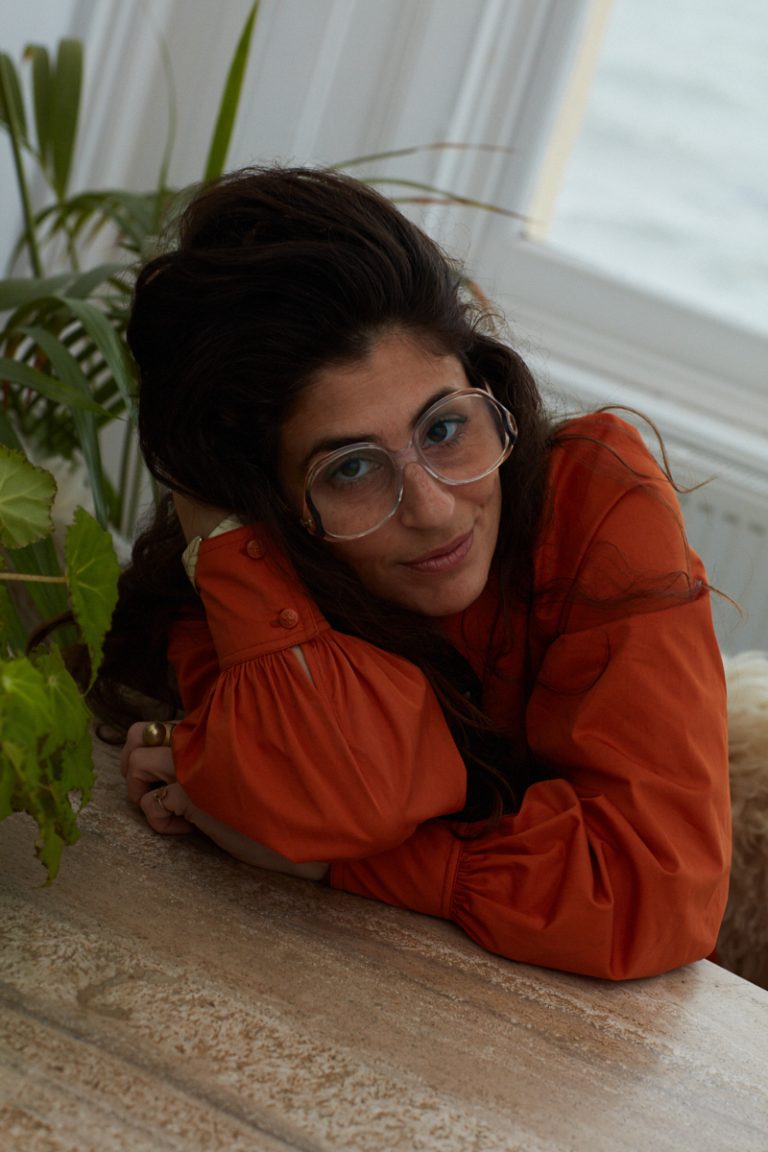
Dress TORY BURCH.
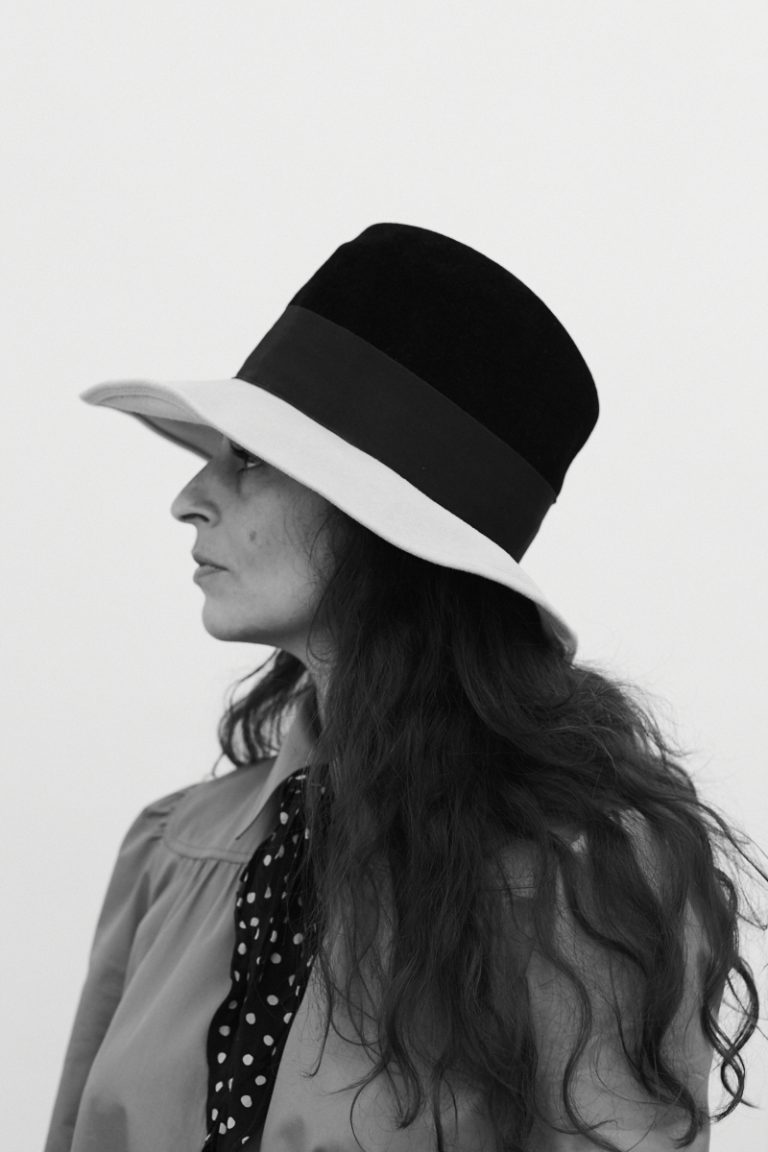
Dress TORY BURCH, Scarf VINTAGE, Hat LEILA'S OWN.
Absolutely. And it’s interesting, too, just linguistically within English. There isn’t any word for ‘death-life’. In a lot of other languages, words exist to explain death and life’s connection. There is a poet who’s written about this, Cecilia Vicuña. She has written about this embrace of death and life simultaneously. I love what you’re saying about the ancestors too. I’ve been thinking about that, even in terms of biology and animals that are no longer present. Or flora or fauna that’s absent from the Earth as well.
Yeah. How can we contact the spirit of the forests that have been depleted?
What are your thoughts on sadness? Because I think that’s also something which seems so prevalent right now.
I think it’s important to reframe sadness to grief... Because I would say sadness is something that can be a tone that moves through. Grief is also such an honouring of the utter sacredness of life, and the profundity of the sacredness of life. And also, the immensity of our humanity and how much there is to grieve.
I mean for me, I’m a ritual griever. It became clear to me not so long ago, a couple of years ago, that I wasn’t going to birth a child through my body in this lifetime. It’s something I deeply long for. And I would do this practicing ritual grieving. I would do what the Irish would call ‘keening’. And I had the amazing good fortune to stay in this monastery, and I was doing a workshop for a couple of weeks in the Bay Area. And I stayed in this wonderful monastery in Berkeley, up in the hills. And I ran into this guy who was doing his PhD on keening at a religion and spiritual practices school at University of California, Berkeley. He was a part of that, and doing his PhD. And he was telling me about it, and it inspired me so much. I knew exactly what I needed to do when I got home.
And so, I think we must grieve. I’m very moved by the stories told by Malidoma Patrice Somé, whose book Of Water and the Spirit speaks of this pattern in the community, in his tribe, where in the neighbouring villages, all part of the same tribe, that they would come together.
He said that whenever anyone died, they would have a four-day grieving group ritual. And people who didn’t even know the person who died particularly well would come, and they would do these waves of different patterns of grief, dancing and crying and wailing, and being very joyful, and all these different activities. And he said that then afterwards, there would be this release of energy and this refreshment of the whole spirit of the people. And then he also said that just when things would start getting a little tense, and you could notice there were a few more arguments and things were a little more... Everybody was a little tenser, someone would die, and then the whole thing would start again. Amazing. It’s always inspired. That book is just packed with inspiration for humanity. That guy is a real... What a gift he’s offered people to know. What astonishing gifts the Dagara [of West Africa] elders can offer the world through allowing him to share some of their practices.
Yeah. It’s an amazing book. And that really moved me a lot. And I think Donna Lancaster, here in the UK, has done some amazing work on encouraging people to step into... I really want to do her grieving workshop, The Bridge. I’ve heard wonderful things. I sat with an ayahuasca ceremony at one point, and had multiple different... A few times I’ve done this, and not every time, but several of these medicine ceremonies that I’ve been a part of have allowed me to do a big release of grief. It’s so holy, isn’t it? That’s the holy water, right? We have the holy flame, and that holy water is so important as well.
I’m really happy that you reframed my question on sadness to grief. It’s hard to admit how much trauma we all carry. It’s very frightening to recognise that trauma and also try to acknowledge it and see what can happen with it through exploration and acknowledgement.
Do you have a lemniscate tattooed on your hand?
I do, yeah. I thought I was a super punk teenager, so this was a stick and poke when I was 16.
Oh, what a good one. One of the circles I travel with are priestesses of the Melissae. They’re bee priestesses. And there’s a lot of work with the lemniscate. And so this is a very potent symbol for me. Seeing it on your hand, it makes me think, ‘I’ve got to get a lemniscate on my hand.’ And how amazing. I’m so inspired by it.
I was a very lost teen but had a lot of determination to live. Despite my best efforts to kill myself constantly. But always that connection between life and death.
Between the worlds. The liminal space right in between. It’s potent. Yeah. That’s the priestess world, is going right into that, into those territories. And just hanging out there.
I notice a medallion on your neck.
This is the Miraculous Medallion, from a church in Paris, which is the Chapel of Our Lady of the Miraculous Medal on Rue du Bac, just by the Bon Marché. And this is the form of the Divine Mother... She originated because she appeared to Saint Catherine Labouré in a vision. She’s the generative blessings—she’s basically the blessings mother. She is the form of the Divine Mother who bestows blessings. And she bestows the blessings that you know how to pray for and beg for and yearn for and long for. She also bestows all the blessings that you don’t know that you need. It’s a powerful... And she’s a very significant figure for my priestessing and for my life. And my orientation in life is just to embody that blessings mother.
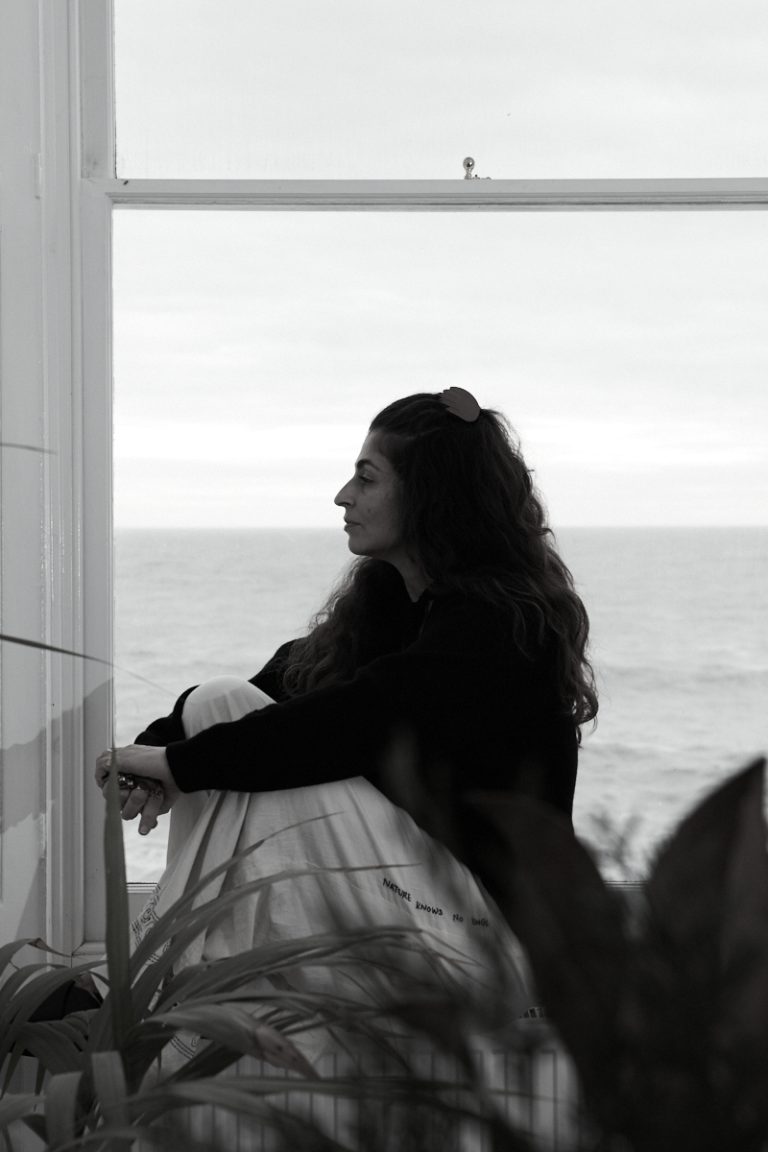
Jumper MARGARET HOWELL, trousers SUPERNATURAE, hairclip COUCOU SUZETTE.
Related Articles

Liberty 150 x150 curated by Leith Clark: The Founder Interviews

Liberty 150 x150 curated by Leith Clark: The Founder Interviews

Liberty 150 x150 curated by Leith Clark: The Founder Interviews

Liberty 150 x150 curated by Leith Clark: The Founder Interviews
